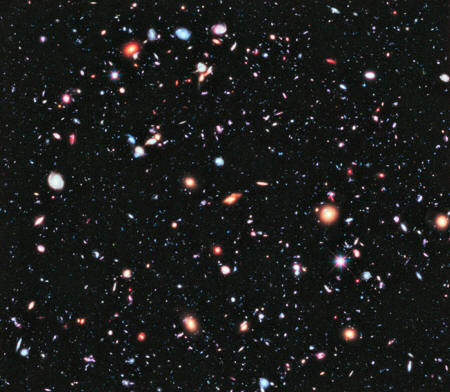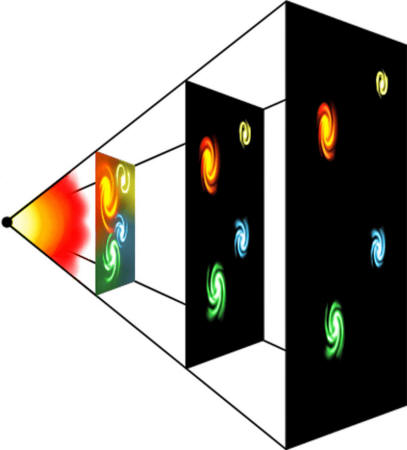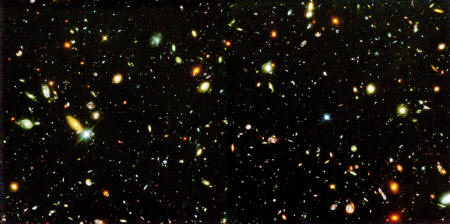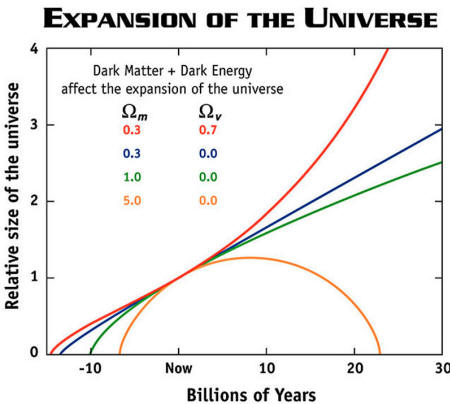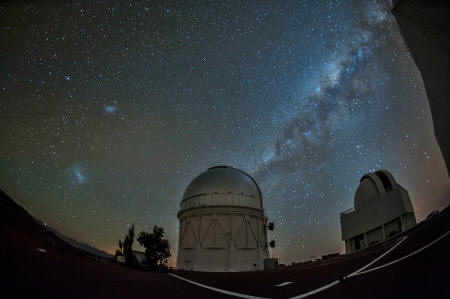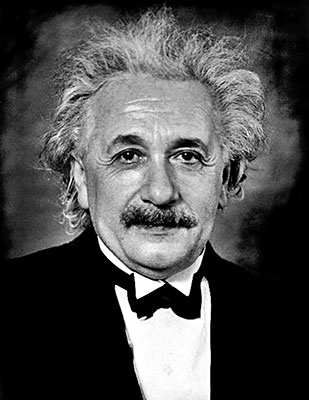|
|
|
from
TheConversation Website
but seems to be pushing our universe apart ever faster? NASA, ESA, G. Illingworth, D. Magee, and P. Oesch (University of California, Santa Cruz),
R. Bouwens (Leiden University),
and the HUDF09 Team, CC BY
But what, exactly,
is dark energy, and why do we even
believe that it exists?
Of course, if you threw the ball hard enough (about
25,000 miles per hour) it would actually escape from the Earth
entirely and shoot into space, never to return. But even in that
case, gravity would continue to pull feebly on the ball, slowing its
speed as it escaped the clutches of the Earth.
This would be an astonishing event, but it's exactly
what astronomers have observed happening to the entire universe!
at different points in time as the universe expands.
Ăvar Arnfj÷r Bjarmason, CC BY-SA
And until recently, scientists believed that there were only two possible options for the universe in the future. It could expand forever (like the ball that you tossed upward at 25,000 miles an hour), but with the expansion slowing down as gravity pulled all of the galaxies toward each other.
Or gravity might win out in the end and bring the
expansion of the universe to a halt, finally collapsing it back down
in a "big crunch," just like your ball plunging back to the ground.
But how could they do this without building a time
machine?
By looking at distant supernovae, which are tremendously bright exploding stars, astronomers can look back hundreds of millions of years.
They can then measure the expansion rate back then by comparing the distance to these far-off supernovae with the speed at which they are flying away from us.
And by comparing how fast the universe was expanding
hundreds of millions of years ago to its rate of expansion today,
these astronomers discovered that the expansion is actually speeding
up instead of slowing down as everyone had expected.
in the Hubble deep field apart?
NASA and A. Riess (STScI)
But how can gravity be repulsive, when our everyday
experience shows that it's attractive? Einstein's theory of gravity
in fact predicts that gravity can repel as well as attract, but only
under very special circumstances.
Dark energy appears to be smoothly smeared out
through the entire universe, and it interacts with ordinary matter
only through the action of gravity, making it nearly impossible to
test in the laboratory.
was described by the yellow, green, or blue curves.
But surprise, it's actually the
red curve instead.
Vacuum energy has another strange property.
Imagine a box that expands as the universe expands. The amount of matter in the box stays the same as the box expands, but the volume of the box goes up, so the density of matter in the box goes down. In fact, the density of everything goes down as the universe expands.
Except for vacuum energy - its density stays exactly
the same. (Yes, that's as bizarre as it sounds. It's like stretching
a string of taffy and discovering that it never gets any thinner).
looking for finer details that can build on what we suspect about dark energy.
Reidar Hahn
Different theories for dark energy predict small differences in the way that the expansion of the universe changes with time, so our best hope of probing dark energy seems to come from ever more accurate measurements of the acceleration of the universe, building on that first discovery 17 years ago.
Different groups of scientists are currently undertaking a wide range of these measurements.
For example, the
Dark Energy Survey is mapping out
the distribution of galaxies in the universe to help resolve this
puzzle.
Could Einstein's theory need work?
Sophie Delar
This would be a daunting undertaking, since Einstein's theory works exceptionally well when we test it in the solar system. (Let's face it, Einstein really knew what he was doing).
So far, no one has produced a convincing improvement on Einstein's theory that predicts the correct expansion for the universe and yet agrees with Einstein's theory inside the solar system.
I'll leave that as a homework problem for the reader.
|


